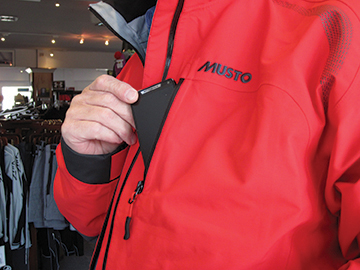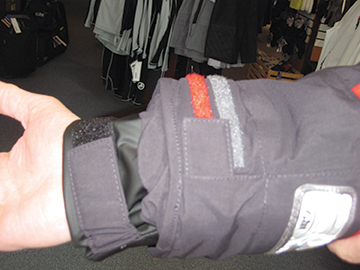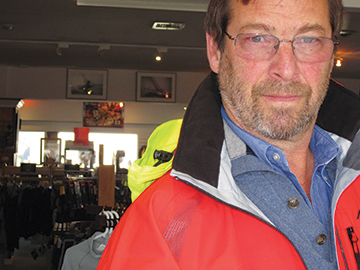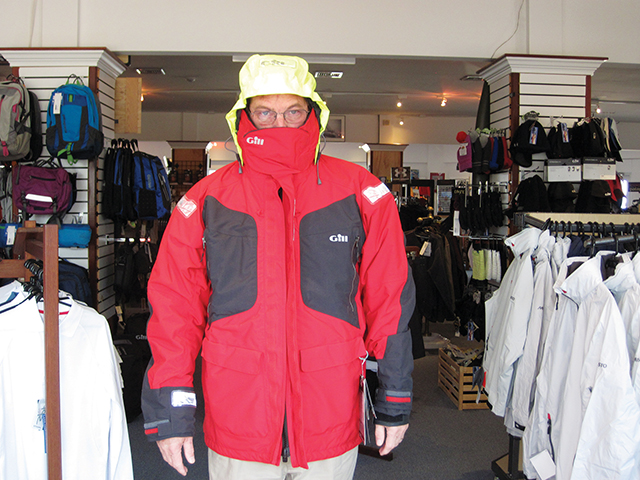(published May 2014)
Thirty-five years passes in a blink when looking back. Cell phones were non-existent. Few beyond the Department of Defense had a computer—and those required a room-sized space to grind out a few relatively simple solutions. It’s little wonder that high tech sailing clothes for most people consisted of Irish wool sweaters and semi-permeable foul weather gear. During the mid-seventies, the only clothing with fleece came from sheep, and when wet, the source became both odious and obvious. Now, however, clothing makes it possible to stay dry and warm in the worst weather.

Safety, comfort and personal effectiveness hinge on staying dry, warm and well rested. To one degree or another, that means one must wear the right clothing for the conditions. Staying dry sounds simple, yet it’s more complicated than most people think. Of course, we have many great types of foul weather gear from which to choose: Musto, Henri Lloyd, SLAM, West Marine and Gill to name only a few. There are many others. If cost is your primary constraint, fishermen have been using Grundens and other types of commercial gear for many decades. It has certainly worked for the guy dragging for scallops year-round. It will keep seawater out and a lot more of your money in your back pocket. But, that’s only part of the story.

Staying dry is not just about keeping seawater out. Most of the higher end sailing foul weather gear is made of breathable fabric—material that allows humidity from perspiration out while keeping the larger water molecules from penetrating the material. It sounds good, and when new, you’ll see water bead on the outside of your spanking new foul weather gear. But to keep that breathable material effective, you need to keep it clean and treat it annually.
Commercial fishermen’s gear, on the other hand, is a “rubberized” material that acts as a moisture barrier in both directions. You won’t get salt water going through the material, but you will also have moisture build up on the inside of the foul weather gear from perspiration. As the vapor on the inside comes in contact with the colder air outside the fabric, the vapor will condense, leaving moisture on the inside of the foul weather gear—moisture you created but will nonetheless dampen your other clothing.

Regardless of the type of outer foul weather gear you’re wearing, you will perspire. The body gives off moisture, and the more active you are, the more perspiration will result. We all know that, but we don’t always accommodate that fact. In order to minimize the amount of perspiration, we should attack that problem in several ways: layering, ventilating and wicking the moisture away from our bodies.
Even in extreme cold conditions, when working hard, we can perspire, and when we cease working so hard, the built up moisture can rapidly cause us to get cold, leading to discomfort or even hypothermia in extreme cases. We may be protected from the seawater, but we need to stay dry from all moisture in order to maintain warmth. Having multiple layers of progressively heavier clothing allows us to strip off the outer layer when working hard and put it back on when we’re at rest.
Typically, when I’m getting ready for cold weather sailing, I’ll wear heavy offshore foul weather gear, a relatively heavy synthetic fleece outer pullover, vest or jacket, a medium weight synthetic pullover and a synthetic silky weight under-layer. Patagonia, Under Armour, Gill and Helly Hansen, to name a few companies, provide these types of layering systems. Similarly, synthetic layering of long underwear helps keep your legs and lower torso warm.
While I like the feel of cotton against my skin in most cases, cotton absorbs moisture and, in a high activity sailing environment, it doesn’t work well. Once cotton is wet with salt water, the only way to get it completely dry is to thoroughly rinse the salt out of the fabric with fresh water and allow it to dry. It will not dry against your skin, the way that non-absorbent, insulating types of synthetic fabric will. Even mere perspiration will maintain a clammy feel with cotton. And the more moisture that the fabric holds, the easier heat will escape from your body.
One of the best ways to stay warm in cold climates is to wear a fleecy, stretchable balaclava. I have one that I picked up in a mountaineering shop. Covering my face, it may make me look like a terrorist, but the fact is that almost 40 percent of your body heat escapes through your head. Stop that leak, and the rest of you will be much warmer. If I’m going to work hard briefly, I may merely take off the balaclava, using the hood on my foul weather gear to remain dry. When I go back to sitting on the rail, I put the balaclava back on.
Of course, all of those things assume that you are actually trying to stay warm. In hot climates, that may not be the case. Wearing just the shear, lightweight inner layer allows moisture to be wicked away from your body, evaporating and cooling your body in the process—the ultimate reason we all perspire. Long sleeved lightweight clothing will also protect us against UV radiation far better than creams, helping us avoid the long term potential of skin cancer. Wide brim hats serve the same purpose.
As we help our bodies cope with environmental conditions, we also help maintain a higher degree of alertness and reduced fatigue. It takes energy to stay warm, and conserving that energy allows us to better utilize energy for other tasks. Warm, all-weather sleeping bags or lightweight sleeping bags should be selected to allow for moisture and ventilation. Wet bags don’t work well, and wet down bags may be the worst of all possible solutions. Even while sleeping, you need to be warm, dry and comfortable. For my own sleeping bag, I have a Quallofil bag, good to -20 degrees F and covered with a breathable waterproof shell. Given my sometimes radical sailing situations, on one or two occasions it may have saved my life.
Ultimately, the clothes and equipment we choose are meant to keep us more comfortable, effective and in some cases even safer. We have come a long way with harnesses, knives, headlamps and other gear that is meant to accomplish that goal. One area that is only now beginning to get the attention it deserves is the use of a helmet while sailing.
Sailing helmets can be used in a variety of circumstances, including protecting the helmsman from an onslaught of flying fish, but primarily I’ve used my Gath helmet while ascending the mast. I know for a fact that it has saved both my head and Rich Wilson’s head from banging into the rig each time we went aloft on Great American II, the trimaran aboard which we set the San Francisco to Boston and New York to Melbourne, Australia records. That alone was worth employing a helmet. If you think it is a good idea to wear a helmet while riding a bike when your head is only six feet above the pavement, you might consider wearing a helmet when your head is 80 or 100 feet above the deck and the mast is gyrating inches from your brain.
These are exciting times for technologies of all kinds. We’ve come a long way from the room-sized computers that were required to solve modest problems. We have also come a long way towards making sailing a warm, comfortable and safer sport in all kinds of conditions. And I would encourage you to consider the possibilities.
Bill Biewenga is a navigator, delivery skipper and weather router. His websites are www.weather4sailors.com and www.WxAdvantage.com. He can be contacted at billbiewenga@cox.net
All pictures taken at Team One Newport 1-800-VIP-GEAR www.team1newport.com. A special thanks to Arianna Baker for helping with the clothing.
Here are a few of the things that I appreciate in my version of the ideal foul weather suit:
• High fleece collar that can keep me warm and dry quickly like the Gill, Henri Lloyd and Musto offshore models.
• Chafe protection around the mouth and nose with soft fleece or other material.
• Fluorescent green hood that has easy vision up, and side to side. Henri Lloyd has clear plastic, non-fogging “windows” in the side of the hood.
• Reinforced patches in high chafe areas such as seat and knees to extend the life of the suit.
• Ample pockets, preferably fleece lined, that will stay dry.
• Good fit—neither baggy nor overly tight and restrictive. Musto has stretchy shoulder panels in the back of their offshore jacket and Slam has draw strings, adjustable from inside the pockets and good fit.
• Shoulder pocket for personal locator beacon (complete with hole in the top for the antenna) as on the Henri Lloyd offshore jacket.
• Adjustable shoulder straps as on the Atlantis Weather Gear bibs.
• High bibs with front zipper that has zipper car at top and bottom for easy access.
• Internal pocket for cell phone or other things that need protection.
















